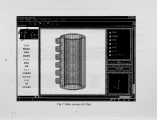| OCR Text |
Show with higher heat flux near the flames. In C a s e 2, high temperature regions caused by the collision of combusting flows are generated near burners in flue mode as shown previously, causing high combined heat flux close to the burners. Conversely, low heat flux regions are observed at 90° and 270° and at the height of burners. In C a s e 3, where a pair of burners is located at the same height, the collision of combusting flows increases the heat flux between the burners, somewhat compensating for the low heat flux region observed in C a s e 2. A relatively uniform heat flux distribution compared to C a s e 2 and C a s e 1 is thus achieved. 5.2.4 Optimum burner arrangement The present numerical results show that the FDI regenerative burner system demonstrates a uniform heat transfer profile to the muffle by the uniform flame and the strong circulation of the hot combustion products. A m o n g the three cases studied. C a s e 3 is proved to be the best for uniform heating while C a s e 1 demonstrates the highest thermal efficiency. Since the uniform heat transfer to the muffle is a matter of great importance for the bright-annealing process. C a s e 3 should be regarded as a optimum burner arrangement. It should be noted that compared with C a s e 2, C a s e 3 allows a relatively simple furnace configuration since pairs of regenerative burners are located at the same height. 6. Industrial furnace design intelligent support system "if-Diss" The previous sections have shown that the computer simulation is capable of predicting the heat transfer characteristics in furnaces to optimize the design parameters such as burner arrangements. Despite the potential advantages, several problems remain in the application of computer simulation to furnace design. Numerical simulation requires much know-how and expertise to model furnaces, and the modeling of various industrial furnaces with a wide range of operating conditions is very time-consuming. To overcome these problems, Tokyo Gas has developed an intelligent program named 'if-Diss' (Industrial Furnace Design Intelligent Support System)'41. It allows interactive preprocessing for the numerical simulation with powerful database of various analytical models and useful grid generator. If-Diss can predict furnace performance in a short period of time. It has modeled more than 70 furnaces. A development of more sophisticated one is now in progress as a project of Japanese three major gas supplying companies (Tokyo Gas, Osaka Gas and Toho Gas). Fig.11 shows one of the main screens of if-Diss ver.2. Coded with J A V A language, the new version can be used by an internet browser via the internet or intranet. If-Diss ver.2 can create the numerical models not only for C D F S - F L O W 3 D but also F L U E N T and S T A R - C D . A wider application of if-Diss is expected. 8 |




















